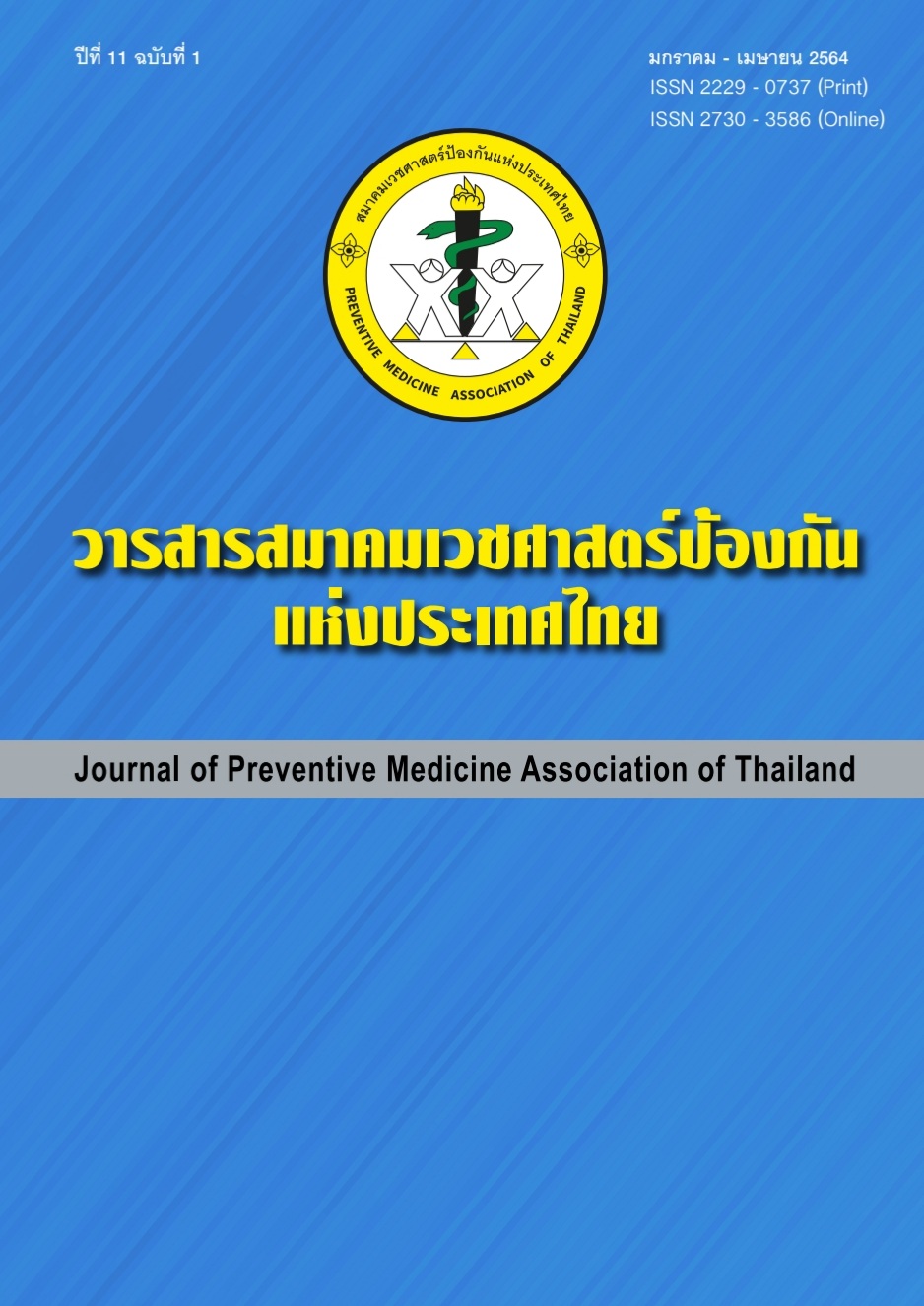Factors Associated with Insomnia Symptoms among Elderly in Primary Care Unit
Keywords:
insomnia, elderly, depression, stressAbstract
Insomnia is the most common sleep disorder of any age. Most of older adults experience symptoms of insomnia and this can be attributed to age-related sleep change pattern. One-third of elderly patients reported insomnia symptoms.(1) By understanding these factors, it may be possible to resolve their problems and also minimized the long-term complication from insomnia. Moreover insomnia may also be one of early signs in many chronic illness conditions including depression. Despites growing study about factors associate with insomnia but not clearly understand in some factors. The objective of this research was to study the factors associated with insomnia symptoms in elderly. In cross-sectional survey conducted from September to December 2020, 300 elderly who aged over 60 were included with 150 persons who experienced insomnia and 150 non-insomnia person equally. Data were collected by a questionnaire which contained general information, factors associated with insomnia, Insomnia severity index, Thai Geriatric Depression Scale (TGDS) and stress test (5ST). Data analysis using descriptive statistics has included percentage, average, standard deviation and analytic statistics such as Independent t-test, Chi square test. The results were analyzed by Binary logistic regression to delineate multivariate analysis. The finding indicates that most of elderly who experienced insomnia were female (76.0%), 70.3 ±6.7 years old on average, married (60.0%) and had inadequate income (59.0%). The factors associated with insomnia in elderly included female, inadequate income, depression, and moderate/high/severe stress level. Many factors are associated with insomnia among the elderly. Screening and observing such factors will allow detection and diagnosis at the early stages in order to decrease a long-term complication.
References
จรียา เขียวผึ้ง, ลดาวัลย์ อุ่นประเสริฐพงศ์, ประคอง อินทรสมบัติ, อรพิชญา ไกรฤทธิ์. ผลของการนวดกดจุดฝ่าเท้าต่อคุณภาพการนอนในผู้สูงอายุที่มีภาวะนอนไม่หลับ. รามาธิบดีพยาบาลสาร 2544;17:90-107.
National Institutes of Health. National Institutes of Health State of the Science Conference statement on Manifestations and Management of Chronic Insomnia in Adults. Sleep 2005;28:1049-57
โชติมันต์ ชินวรารักษ์, สุขเจริญ ตั้งวงษ์ไชย, นัฏศรา ดำรงค์พิวัฒน์. คุณภาพการนอนหลับและปัจจัยที่เกี่ยวข้องในผู้สูงอายุที่หมู่บ้านประชานิเวศน์. วารสารสมาคมจิตแพทย์แห่งประเทศไทย 2561; 63:199-210.
Crowley K. Sleep and sleep disorders in older adults. Neuropsychol Rev 2011;21:41-53.
Ohayon MM. Epidemiology of insomnia: What we know and what we still need to learn. Sleep Med Rev 2002;6:97-111.
Sukying C, Bhokakul V, Udomsubpayakul U. An epidemiological study on insomnia in an elderly Thai population. J Med Assoc Thai 2003;86:316-24.
Kamel NS, Gammack JK. Insomnia in the elderly: cause, approach, and treatment. Am Med 2006;119:463-69.
Lin CL, Chien WC, Chung CH, Wu FL. Risk of type 2 diabetes in patients with insomnia: a population based historical cohort study. Diabetes Metab Res Rev 2018;34(1). doi: 10.1002/dmrr.2930.
Javaheri S, Redline S. Insomnia and risk of cardiovascular disease. Chest 2017;152:435-44.
Czeisler CA, Scammell TE, Saper CB. Sleep disorder. In: Kasper, Fauci, Hauser, Longo, Jameson, loscalzo, editors. Harrison's principle of internal medicine, 19th ed. USA: McGraw-Hill Education; 2015. p.184-9.
Stein E, Katz PO. GERD: GERD and Insomnia-First Degree Relatives or Distant Cousins?. Nat Rev Gastroenterol Hepatol 2010;7:8-10.
Kim WJ, Joo WT, Baek J, Sohn SY, Namkoong K, Youm Y, et al. Factors associated with insomnia among the elderly in a Korean rural community. Psychiatry Investigation 2017;14:400–6.
Dangol M, Shrestha S, Rai Koirala SK. Insomnia and its associated factors among older people of selected ward of Banepa municipality, Nepal. Nurs Open 2020;7:355–63.
ดุสิต จันทยานนท์, อัญญา เกียรติวีระศักดิ์, วรรษมน อินทรประสงค์, วิรดา อนันตวงศ์, มนสิชา งามภูพันธ์, วราพร พงศ์มรกต, และคณะ. การศึกษาความชุก ปัจจัยที่เกี่ยวข้องของภาวะนอนไม่หลับและพฤติกรรมการใช้ยานอนหลับในผู้สูงอายุที่มีอายุตั้งแต่ 60 ปีขึ้นไป ในชุมชนวัดอินทาราม ตำบลหัวรอ อำเภอพระนครศรีอยุธยา จังหวัดพระนครศรีอยุธยา. วารสารสมาคมเวชศาสตร์ป้องกันแห่งประเทศไทย 2555;1:12-24.
ธัญวรรณ เพ็ชรน้อย. ปัจจัยที่สัมพันธ์กับภาวะนอนไม่หลับในผู้สูงอายุที่มารับบริการในหน่วยปฐมภูมิ โรงพยาบาลภูมิพลอดุลยเดช. วารสารระบบบริการปฐมภูมิและเวชศาสตร์ครอบครัว 2563;2:51-73.
พัทรีญา แก้วแพง. ความสัมพันธ์ระหว่างปัจจัยคัดสรรกับอาการนอนไม่หลับของผู้ป่วยมะเร็งวัยผู้ใหญ่[วิทยานิพนธ์ปริญญาพยาบาลศาสตรมหาบัณฑิต]. กรุงเทพฯ:จุฬาลงกรณ์มหาวิทยาลัย; 2547.
Train The Brain Forum Committee (Thailand). Thai Geriatric Depression Scale. Siriraj Medical Journal 1994;46:1-9.
อรวรรณ ศิลปกิจ. แบบวัดความเครียดฉบับศรีธัญญา. วารสารสุขภาพจิตแห่งประเทศไทย 2551;16:177-85.
Li RHY, Wing YK, Ho SC, Fong SYY. Gender differences in insomnia - A study in the Hong Kong Chinese population. J Psychosom Res 2002;53:601–9.
Paine SJ, Gander PH, Harris R, Reid P. Who reports insomnia? Relationships with age, sex, ethnicity, and socioeconomic deprivation. SLEEP 2004;27:1163-9.
พวงสร้อย วรกุล, สุขเจริญ ตั้งวงษ์ไชย, ณภัควรรต บัวทอง. ปัจจัยเสี่ยงต่อการนอนไม่หลับในพนักงานต้อนรับบนเครื่องบิน. วารสารจิตวิทยาคลินิก 2547;37:34-45.
ยุพาวดี ขันทบัลลัง. ความสัมพันธ์ระหว่างความเครียดกับคุณภาพการนอนหลับในผู้สูงอายุ. วารสารวิจัยและนวัตกรรมทางสุขภาพ 2561;1:16-30.
Ebrahim IO, Shapiro CM, Williams AJ, Fenwick PB. Alcohol and sleep I: effects on normal sleep. Alcohol Clin Exp Res 2013;37: 539-49.
Brook JS, Zhang C, Rubenstone E, Brook DW. Insomnia in adults: The impact of earlier cigarette smoking from adolescence to adulthood. J Addict Med 2015;9:40–5.
Passos GS, Poyares D, Santana MG, Garbuio SA, Tufik S, Mello MT. Effect of acute physical exercise on patients with chronic primary insomnia. J Clin Sleep Med 2010;6:270-5.
Downloads
Published
How to Cite
Issue
Section
License
บทความที่ลงพิมพ์ในวารสารเวชศาสตร์ป้องกันแห่งประเทศไทย ถือเป็นผลงานวิชาการ งานวิจัย วิเคราะห์ วิจารณ์ เป็นความเห็นส่วนตัวของผู้นิพนธ์ กองบรรณาธิการไม่จำเป็นต้องเห็นด้วยเสมอไปและผู้นิพนธ์จะต้องรับผิดชอบต่อบทความของตนเอง






